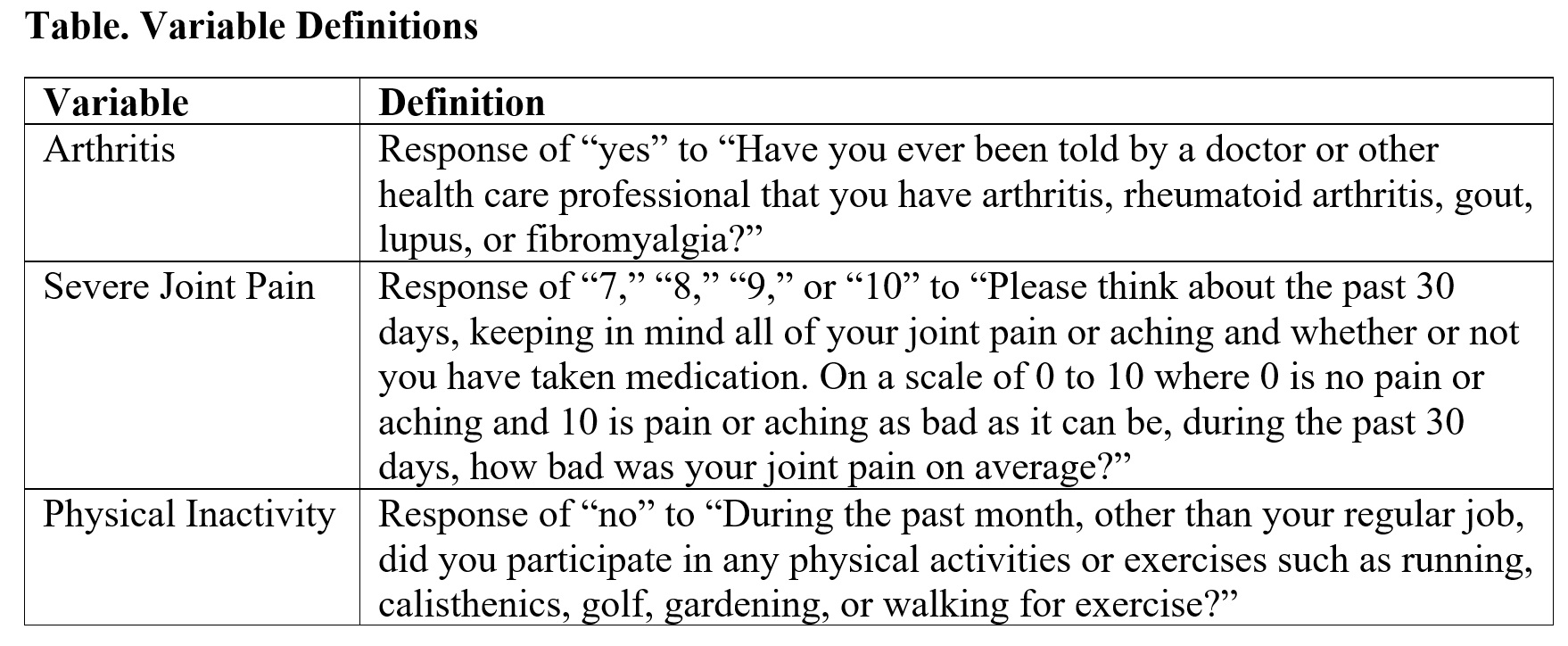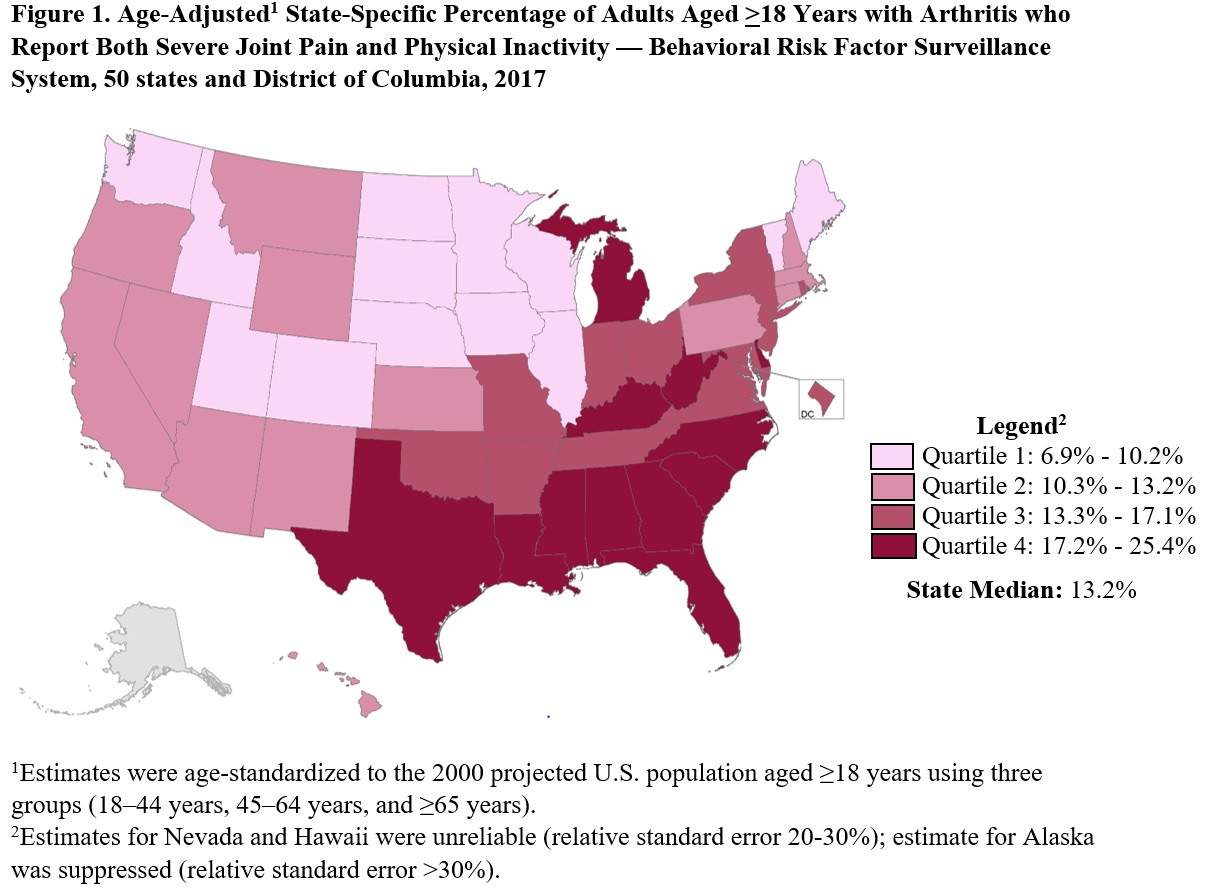Session Information
Date: Saturday, November 7, 2020
Title: Epidemiology & Public Health Poster II: OA, Osteoporosis, & Other Rheumatic Disease
Session Type: Poster Session B
Session Time: 9:00AM-11:00AM
Background/Purpose: About one in four (27%) US adults with arthritis have severe joint pain, and only 36% meet the Physical Activity Guidelines for Americans. While low-impact physical activity can relieve arthritis pain, improve physical functioning, and prevent or delay arthritis-related disability, pain itself is the most frequently reported barrier to physical activity among adults with arthritis. The study purpose was to estimate, among adults with arthritis, percentages of reporting both severe joint pain and physical inactivity: 1) for each of the 50 states and District of Columbia, and 2) overall by selected sociodemographic and health-related characteristics.
Methods: We analyzed 2017 Behavioral Risk Factor Surveillance System data (unweighted n=134,405 adults with arthritis). We used standard definitions of arthritis, severe joint pain, and physical inactivity (Table). We generated age-specific or age-adjusted percentages with 95% confidence intervals (CIs) for all outcomes. Differences between subgroups were assessed using t-tests and linear patterns in ordinal variables using tests for trends (i.e., orthogonal linear contrasts) (α=0.05). We accounted for the complex survey design by applying sampling weights and adjusting variance.
Results: In 2017, the median state age-adjusted percentage of reporting both severe joint pain and physical inactivity among adults with arthritis was 13.2% (range: 6.9% [Wisconsin]-25.4% [Mississippi]), with higher percentages in South and Southeast states (Figure 1). Age-specific percentage was higher among those aged 45-64 years (17.3% [95% CI: 16.6-18.1]) compared with those aged 18-44 years (14.2% [95% CI: 12.9-15.6]) and those aged >65 years (13.2% [95% CI: 12.6-13.9]). Age-adjusted percentages were highest in their respective subgroups for females (17.2% [95% CI: 16.1-18.3]), those with < high school graduation (27.9% [95% CI: 25.0-31.0]), non-Hispanic blacks (24.2% [95% CI: 21.5-27.0]) (Figure 2), Hispanics (19.7% [95% CI: 17.3-22.4]) (Figure 2), and those with obesity (18.5% [95% CI: 17.2-19.9]). Age-adjusted percentage for those unable to work/disabled (36.7% [95% CI: 34.4-39.0]) was more than four times higher than for those employed/self-employed (8.8% [95% CI: 8.0-9.6]). Age-adjusted percentage was similar across urban/rural geographic areas, ranging from 14.9%–17.1% in all areas, except for a slightly lower prevalence (13.1%) in large fringe metro areas.
Conclusion: Across states, about 1-in-8 adults with arthritis reported both severe joint pain and physical inactivity. The percentage was even higher among specific subgroups (e.g., 1-in-3 adults unable to work/disabled, 1-in-4 non-Hispanic blacks), making them an important target for evidence-based physical activity programs. These programs, available in most states, can safely reduce the compound effects of severe joint pain and physical inactivity by helping adults with arthritis reduce pain and increase physical functioning and quality-of-life.
To cite this abstract in AMA style:
Guglielmo D, Murphy L, Hootman J, Boring M, Theis K, Helmick C, Carlson S, Liu Y, Lu H, Croft J. State-Specific Percentage of Adults with Arthritis Who Report Both Severe Joint Pain and Physical Inactivity and Their Characteristics, United States, Behavioral Risk Factor Surveillance System, 2017 [abstract]. Arthritis Rheumatol. 2020; 72 (suppl 10). https://acrabstracts.org/abstract/state-specific-percentage-of-adults-with-arthritis-who-report-both-severe-joint-pain-and-physical-inactivity-and-their-characteristics-united-states-behavioral-risk-factor-surveillance-system-2017/. Accessed .« Back to ACR Convergence 2020
ACR Meeting Abstracts - https://acrabstracts.org/abstract/state-specific-percentage-of-adults-with-arthritis-who-report-both-severe-joint-pain-and-physical-inactivity-and-their-characteristics-united-states-behavioral-risk-factor-surveillance-system-2017/



